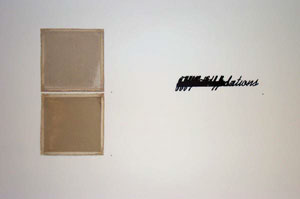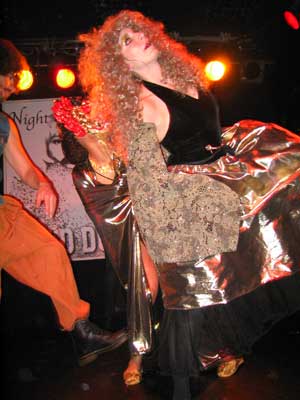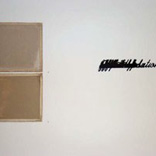Initially, in talking with several members of UT Austin's MFA program, I sought to examine how new uses of video are shaping the department. I spoke to three artists who have very different approaches to the medium: Jared Steffenson's video developed organically from his sculptural work; Erick Michaud approached video as a narrative medium; and Jill Pangallo's videos are closely related to her character-based performance practice.
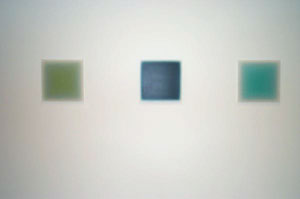
But after viewing their work, I'm struck by more than just the differences in their use of the video medium. Instead, a fundamental similarity connects them, principally their reliance on humor to expand or unsettle their art.
What does it mean to laugh at art? How do we know when we're laughing for the right reasons? (Or maybe the right reasons aren't all that important.) Humor in a work of art can destabilize the viewer, especially in the hallowed setting of the gallery, where laughter often seems out of place. If my first reaction is to laugh, I often doubt my own response. It's slightly embarrassing because I assume I have missed something important, that some lofty message has passed me by. But destabilization isn't necessarily a bad thing. As I question my response, I'm also likely to interrogate the work more closely. In other words, catching the viewer off guard through the use of humor can encourage a more critical mode of viewing. As Steffenson, Michaud and Pangallo all draw from the experience of the everyday for subject matter, humor — as different as it is in each artist's work — serves to make common experience strange again.
Jared Steffenson
Steffenson's work is equal parts physicality and whimsy. To a certain extent, he constructs the objects he makes out of building materials and craft supplies without regard for the 'real' proportions of their referents, but instead with an eye to the human body. Based in Steffenson's personal memory of childhood and of home, which lends their profound physical presence an air of nostalgia, the sculpture seems to represent a remembered reality.
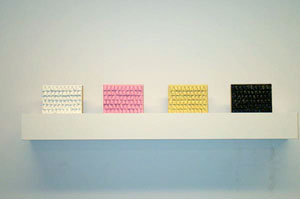
Steffenson's objects can be small and precious or large and cumbersome. The inclusion of found objects, like tennis shoes or a suit coat, helps to ease the transition between fantasy and the real, making the final sculptures seem familiar in spite of their obvious idiosyncrasies.
At the 2005 Gallery 3 show No Place Like Home, Steffenson's Tree Watch, his portable mountain and his Landscape Shoes formed a coherent group of sculptures that suggested that the fantastic can be straightforward, fully integrated into everyday life. Steffenson's natural accessories within the work draw in the viewer. When you look at the small sculpture Tree Watch, you can imagine yourself wearing it and even understand why Steffenson might seek to carry this landscape on his shoulder, his memory home, around with him. In a recent statement, the artist wrote:
The objects from these worlds want so badly to be believed in. They want the viewer to ignore how pathetic they look. They want the viewer to disregard what they are made of and how they are made. They want to be played with. They want the viewer to become part of their reality.
All of Steffenson's objects imply a kind of performance: They are meant to be worn (or at least they appear so). They adamantly suggest their own use value, even if that value is hypothetical. In that sense, Steffenson's work was already performative even before he moved to recording his use of the objects on video.
In his recent video work, the artist has moved from implying the sculptural object's utilitarian potential to demonstrating it. In May I have this Dance Tree, he recorded himself engaged in a tender encounter with a tree on casters; performing against a naïve background, he sweeps the tree up into a dance number inspired by the 1952 film Just for You. As he dances, maybe a little clumsily, the tree seems to act like an accessory to remembering or imagining, an instrument that illustrates the sweetness of memories or fantasy. Which is not to say that the video itself isn't a little silly. In fact, humor plays an important role in the piece, as the absurdity of the situation keeps the wistfulness from becoming treacly.
Humor is equally important in another recent video of Steffenson's, A Walk in the Shade, which shows the artist wearing the Tree Shoulder Harness strapped to his right shoulder as he makes his way down the street on his morning commute. The tree, with its associations of home, accompanies the artist like a talisman. But it has a more practical function, too, providing a bit of personalized shade from the glare of the Texas morning sun. It's patently silly, but it works so well that by the end of the sequence, I almost forgot just how silly it was. Steffenson's demeanor as he interacts with these objects makes it easy to forget the absurdity; his expression is almost somber, and his body language is matter-of-fact, deflecting the ridiculous quality of what he's doing. He absorbs the accessories and they absorb him, and it all looks perfectly natural.
In his video work, Erick Michaud has found humor in the uncomfortable moments of everyday life. The End of an Age is one of a pair of videos that feature Michaud working through scenarios of insecurities, a subject perhaps familiar to the thirty-something man first noticing early signs of physical aging and the loss of youth. Here the character, played by Michaud but not necessarily him, acts out the ultimately banal fantasies of a man confronted with a receding hairline. With metal music faintly audible as it leaks out of a pair of headphones, he plays air guitar in one final fling as a headbanger, long hair flying.
Watching the video can be uncomfortable. During my first viewing, the audience wasn't sure whether it was okay to laugh at this footage, which was both achingly embarrassing and truly hilarious. In fact, although the piece can sustain an extended reading, I think it's important to be clear that it is, at its heart, beautifully funny. It is funny because it is simple and clear, because the emotional tension of the situation is uncomplicated and accessible, and because it makes us feel vulnerable as we watch it.
Some of Michaud's other work pursues a more absurd, but still ultimately familiar kind of humor in its documentation of a character known as the Herald of Doom. Clothed in a black robe, the Herald has a demonic skull for a head and wears a helmet with fierce-looking horns while the word 'Psuche' (Greek for 'soul') is scrawled on tape across his forehead. Physically, the figure is genuinely disquieting, but Michaud sets the Herald up in situations that subtly undermine his power. In Herald of Doom , the Herald stands on top of an outsized iconic drawing of a thundercloud and sings about death and destruction, nodding along with the howling electronica of the soundtrack and occasionally shaking a little rattle in time to the beat. As he intones, "There is no culture, I am culture; there is no state, I am state; there is no fear, I am fear," the heavily modulated voice never quite succeeds in lending those words the necessary gravitas. This and the cartoonish background (with the evident greenscreen technology) take much of the punch out of the Herald's proclamations: he is laughable, but he's also just funny.
In Michaud's recent contributions to the UT Austin MFA show, the Herald has become a more full-fledged character with a life outside of Armageddon. Hired Gun shows a singing telegram performer delivering a campy, a cappella rendition of the Herald's original song on the street. In the video, the Herald is seen adjusting the audio equipment and the smoke machine before the show, then walking through the shot with a handheld camera taking closeups during the performance.
This time, the apocalyptic message is not backed by shrieking electronic music; there's something more fragile about this a capella rendition. The woman's slightly quavering voice carries even less of a punch than did the Herald himself in Herald of Doom. At the same time, the Herald character takes on a fuller persona, one enhanced in the gallery by an installation showing the Herald's workspace. The Herald's Myspace page visible on the computer gives us a little glimpse into the interests and talents of the character. In its profile photo, posed against a woodland scene, the Herald holds up a smallish trophy fish. Clearly the Herald's just like the rest of us, enjoying the pleasures of life while waiting for doomsday to roll around.
Both Steffensen and Michaud create fantasies that are distinctly down-to-earth, and Jill Pangallo's performance and video work similarly relies on observations from everyday life that the artist exaggerates or inverts. Pangallo's subjects are just as likely to be glamorous stars as they are to be tacky white-collar workers. The surreal characterizations she produces are successful precisely because they embody something very like what we encounter in ourselves and in others day to day.
Pangallo's ongoing project Hot Sausage, which she performs with Wilson Chan, Roger Padilha and occasionally Liz Collins, follows the career of the musical and dance trio Hot Sausage. Hot Sausage performs live, but a video of the group is an essential part of those performances, providing additional visuals that supplement and heighten the overall drama and glamour of the scene. Video acts like a repeater of the group's fictional fame.
The video Burning Up — Hot Sausage Does Vegas provides a representative glimpse into the aesthetic of Hot Sausage, with the added sass of a soundtrack and montaged highlights. In Vegas for an aerobics convention, Hot Sausage faces a brief crisis when the two guys, Mickey and Marco, don't seem to be taking Piggy, their girl lead, or the engagement very seriously. This is established during the credits, but the narrative isn't as important as the various tableaus that inscribe the characters' exotic presence onto the already over-the-top Vegas landscape. Their sophistication, or maybe the artificiality of their sophistication, surfaces in a sequence in which the three appear in front of Vegas's 'international' landmarks ? the Eiffel Tower at the Paris Resort or the gondolas of the Venetian ? and is driven home by a cameo from the king of camp himself, Sir Elton John (in wax, of course).
Pangallo's production focuses on the pouting and posturing of her characters, a theatricality that makes the story both campy and fun to watch. But a fictional rapport between the characters reads as genuine rapport between the performers, which is endearing. The humor is thus underscored by a note of sweetness, and instead of making fun of the small-time acts that Hot Sausage is modeled on, the performance becomes a sensitive depiction. And since we are in Vegas, this is illustrated for us rather nicely by — wait for it — the threesome's wedding in a little chapel.
Pangallo's recent collaboration with Virginia Yount, 2112 Flexagon Hills, is a radical shift away from the Hot Sausage videos. But while the piece is more surreal, its subject remains somehow familiar and understandable, resonating with popular fears of globalization and automation. The video installation presents a distopia in which androgynous human beings function as worker drones for the galactic conglomerate Totalicorp. As viewers crawl inside the twin bed-sized construction, the Flexagon Hills housing pod, they enter the artists' imagined future, where corporations offer a video sampler of relaxation and entertainment options to their workers. The drones, called 5-Alphas, are hermaphroditic humans (played by Pangallo in a shiny white bodysuit and a knee-length, kinky white wig), willing participants in a neutered, highly regulated lifestyle. A scene of one of these 'intersexual humans' hammering away at a child's xylophone is a unsettling, if silly, vision of the future of culture.
A new video, Sexy Hobo, is a more dislocated example of Pangallo's surreal caricature. Unlike much of her other work, Sexy Hobo lacks any narrative at all; it is essentially a series of images that combine the erotic and the abject. The artist appears in the high-cut costume of a dancing girl, complete with heels and fishnet stockings. But the appeal of this sexy getup is effectively reversed by the trademarks of the cartoon hobo: a ragged top hat and a muddy five-o'clock shadow. As Pangallo high kicks and slinks around a suburban landscape of strip mall, culvert, and Dumpster, her character appears simultaneously attractive and repellant. If the camera's far enough away, the viewer might ignore the beard and be transported by the dancing; but when it zooms in close, there's no mistaking the sorry nature of this figure.
All three artists mine the contradictions of everyday life for their video work. The patent absurdity and inherent humor of our anxieties must offer up endless tantalizing sources for study.
Available at http://uts.cc.utexas.edu/~crlab/2006_01_fourbyeight/3bc.html .
Images courtesy the artists.
Heather Mathews is an art historian living in Austin.


